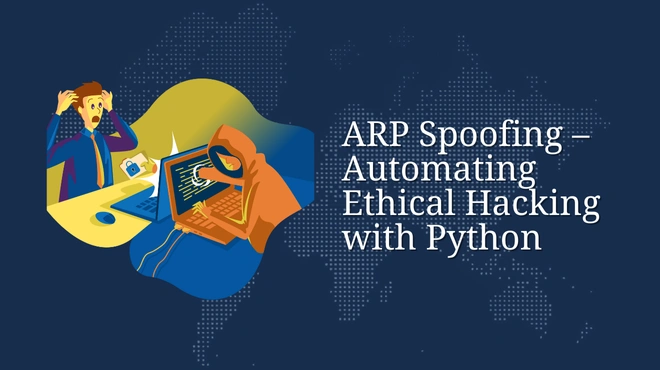
ARP Spoofing – Automating Ethical Hacking with Python
Master ARP Spoofing with Python & Scapy: Learn ARP Poisoning Mechanics, Ethical Hacking Defenses, and Enterprise-Grade Mitigation Strategies
Stop firefighting the same issues. Get the integrated toolkit to lead projects that eliminate waste and deliver measurable results.
You see broken processes every day - waiting, rework, unnecessary motion, overproduction - but without Lean Six Sigma Green Belt certification, your suggestions get overlooked. Certified Lean Six Sigma Green Belts lead cross-functional improvement teams, secure project budgets, and document measurable financial savings that increase their compensation by 35-50%. You know Lean principles and basic Six Sigma concepts, but organizations want proof you can lead structured DMAIC projects and deliver measurable business impact. That's what our program ensures. This isn't another course separating Lean and Six Sigma. Our Lean Six Sigma Green Belt course is designed by Black Belt practitioners who integrate waste elimination with statistical process control in real Seattle, WA manufacturing, IT operations, and healthcare environments. Learn when to deploy Lean tools for speed and when Six Sigma rigor is essential. Unlike programs that focus only on methodology, we build project leadership capability. You'll learn how to lead kaizen events that maintain momentum after the week ends, apply value stream mapping to identify constraint operations, use statistical process control to distinguish signal from noise, and document hard savings that finance teams validate. The certification proves you know integrated Lean Six Sigma - the real value is returning to your organization and leading a project that reduces lead time by 40%+ while cutting defects in half, creating measurable business impact that gets reported to executive leadership. We've built this for professionals in manufacturing, operations, quality, or process roles who need to lead improvement initiatives without abandoning their current responsibilities. Weekday evening and weekend batches, all fully interactive. Every session recorded. Beyond the classroom, you get value stream mapping templates, control plan formats, waste identification checklists, real case studies from Seattle, WA automotive, electronics, and pharmaceutical manufacturing, 24/7 expert support from Black Belts, and hands-on guidance on your certification project - where most candidates fail because they pursue improvements without statistical validation or financial rigor.
Learn with confidence knowing your training program aligns with IASSC standards for Lean Six Sigma Green Belt certification, giving you flexibility to choose the certifying body that matches your industry and budget.
Unlock your leadership potential with expert instructors who hold Six Sigma Black Belt or Master Black Belt credentials and actively lead process improvement portfolios in manufacturing, IT, and service organizations.
Aim for Green Belt certification without disrupting your current role - choose weekday-evening batches, weekend-only schedules, or an intensive 5-day bootcamp that accelerates your learning.
Master advanced DMAIC methodology with 32 hours of hands-on training, real project work, and individualized performance feedback through phase-specific statistical assessments covering hypothesis testing, DOE, and regression analysis.
Eliminate knowledge gaps with 2000+ tailor-made practice questions, full-length mock exams, real project case studies from Seattle, WA manufacturing and service sectors, and statistical software tutorials.
Be worry-free as Six Sigma Black Belt experts are available 24x7 to clarify advanced statistical concepts, review your project documentation, and assist you at every turn from project selection through control plan validation.

Get a custom quote for your organization's training needs.
Stop waiting for permission to lead improvements. You will learn proven techniques for selecting high-impact projects, developing compelling business cases, creating project charters that secure executive sponsorship, and managing cross-functional teams through the complete DMAIC lifecycle without formal authority.
Master it or watch your conclusions get demolished by leadership. You will develop competence in hypothesis testing (t-tests, chi-square, ANOVA), correlation and regression analysis, confidence intervals, and statistical software usage that enables data-driven decisions instead of anecdotal recommendations that get ignored.
Learn to optimize processes systematically instead of guessing. You will create full factorial and fractional factorial designs, conduct multi-vari studies, analyze main effects and interactions, and identify optimal factor settings that maximize quality and minimize cost. This is a core component of our Lean Six Sigma Green Belt training and part of the Lean Six Sigma Green Belt certification program.
Cut through measurement noise to find process truth. You get frameworks and statistical methods for conducting Gage R&R studies, assessing attribute agreement, validating measurement accuracy and precision, and ensuring your data reflects reality before making million-dollar decisions based on flawed measurements.
Build control systems or watch improvements decay within months. You will understand control chart theory, select appropriate chart types (X-bar/R, I-MR, p, c, u), interpret control limits versus specification limits, detect out-of-control conditions, and implement real-time monitoring that sustains gains after project closure.
Technical improvements alone aren't enough - you must document savings. Learn to calculate hard savings, soft savings, cost avoidance, payback periods, NPV, and ROI using methods accepted by finance teams. This ensures that your Lean Six Sigma Green Belt certification translates into measurable business impact and leadership recognition, reinforcing the value of your Lean Six Sigma Green Belt certified status.
If you're ready to lead process improvement projects and meet certifying body requirements (experience varies by organization), this program is engineered to get you certified and project-ready.


Stop getting filtered out by HR systems requiring "Lean Six Sigma Green Belt" for quality manager and continuous improvement leader roles that pay ₹12-18 lakhs annually in manufacturing, IT, and healthcare sectors.
Prove project leadership competence to hiring managers who won't risk appointing unqualified leaders to cost-reduction initiatives that impact quarterly financial results and executive bonuses.
Transition from tactical execution into strategic process improvement leadership where you lead cross-functional teams, present to executives, and earn recognition through documented six-figure cost savings instead of just following procedures.
The Lean Six Sigma Green Belt sits between entry-level Yellow Belt and senior-level Black Belt, requiring demonstrated ability to lead projects and apply statistical methods. Requirements vary significantly by certifying body, so understanding these differences is critical before selecting your certification path.
IASSC Green Belt: No work experience required, no project requirement, exam-only certification. Costs $395 USD for 100 questions in 3 hours. Ideal for career switchers and early-career professionals building credentials.
ASQ Green Belt (CSSGB): Requires either 3 years of work experience in one or more areas of the Six Sigma Body of Knowledge OR 1 year of work experience plus Bachelor's degree. Must complete a project with signed affidavit. Exam costs $438 USD for members (135 questions, 3.5 hours).
CSSC Green Belt: No experience requirement, no project requirement, open-book exam. Costs $295 USD for 100 questions in 2 hours. Most affordable option but less recognized in large corporations.
Recommended Training: While not mandatory for most bodies, formal training dramatically increases pass rates and ensures you can apply methodology in real projects, not just pass exams.
For comprehensive breakdowns of certification body selection, project documentation requirements, and experience qualification criteria, please refer to our detailed FAQ section.
Build detailed process documentation before attempting improvement. In our Lean Six Sigma Green Belt course, you will learn to create value stream maps, detailed process flowcharts, and data collection plans that specify what to measure, how to measure it, who will collect the data, and how to ensure data integrity throughout the Measure phase. This is a crucial skill for every Lean Six Sigma Green Belt certified professional aiming to drive measurable process improvements.
Master the statistical foundation required for hypothesis testing. Learn to calculate and interpret measures of central tendency (mean, median, mode), measures of dispersion (range, variance, standard deviation), understand normal distributions, Z-scores, and probability concepts that underpin all advanced statistical analysis.
Validate your measurement system before trusting the data. You will learn to conduct Gage Repeatability & Reproducibility (GR&R) studies using ANOVA method, assess attribute agreement analysis, interpret %GRR and number of distinct categories, and determine whether your measurement system is adequate for process capability assessment and decision-making.
Quantify whether your process can meet customer specifications. Learn to calculate Cp, Cpk, Pp, Ppk indices, interpret capability metrics, understand short-term versus long-term capability, calculate defects per million opportunities (DPMO), determine sigma levels, and communicate capability gaps that justify improvement investments to leadership.
Master the statistical rigor that separates Green Belts from Yellow Belts. You will learn hypothesis testing theory, Type I and Type II errors, significance levels, p-values, power analysis, and how to select appropriate tests (1-sample t-test, 2-sample t-test, paired t-test, chi-square, ANOVA) based on data type and business questions.
Identify and quantify relationships between variables. Learn to create scatter plots, calculate correlation coefficients, distinguish correlation from causation, conduct simple linear regression, interpret R-squared values, assess residuals, and use regression equations for prediction and process optimization that withstands statistical scrutiny.
Move beyond obvious symptoms to identify true root causes. You will master advanced techniques including multi-vari studies, failure modes and effects analysis (FMEA), fault tree analysis, and systematic brainstorming methods that generate implementable solutions rather than theoretical improvements that never get executed.
Learn to optimize processes through controlled experimentation instead of trial-and-error guessing. Master DOE terminology, full factorial designs, fractional factorial designs, screening designs, analyze main effects and interactions, interpret Pareto charts of effects, and identify optimal factor settings that maximize quality while minimizing cost.
Evaluate improvement alternatives objectively. In our Lean Six Sigma Green Belt certification course, you will learn to conduct cost-benefit analysis, create solution selection matrices, design pilot studies, implement improvements on a controlled scale, collect validation data, and prepare for full-scale implementation with risk mitigation strategies. This ensures your Lean Six Sigma Green Belt certified status reflects practical, real-world capability.
Implement monitoring systems that sustain improvements after project closure. You will learn control chart theory, rational subgrouping, calculate control limits, distinguish common cause from special cause variation, select appropriate charts (X-bar/R, I-MR, p, c, u), and train operators to use control charts for real-time process monitoring.
Create comprehensive control systems. Learn to develop control plans that specify what to measure, measurement frequency, who is responsible, reaction plans for out-of-control conditions, and documentation standards. Understand process audit procedures, standard operating procedure (SOP) updates, and how to transfer ownership to process owners for long-term sustainability.
Close projects with documented results that earn recognition. You will learn to calculate hard savings, soft savings, cost avoidance, validate financial benefits with finance departments, create executive-level presentations, document lessons learned, and complete project closure reports that satisfy certification body requirements and position you for promotion.

Our experts are ready to help you with any questions about courses, admissions, or career paths. Get personalized guidance from industry professionals.
"PMI®", "PMBOK®", "PMP®", "CAPM®" and "PMI-ACP®" are registered marks of the Project Management Institute, Inc. | "CSM", "CST" are Registered Trade Marks of The Scrum Alliance, USA. | COBIT® is a trademark of ISACA® registered in the United States and other countries. | CBAP® and IIBA® are registered trademarks of International Institute of Business Analysis™.


